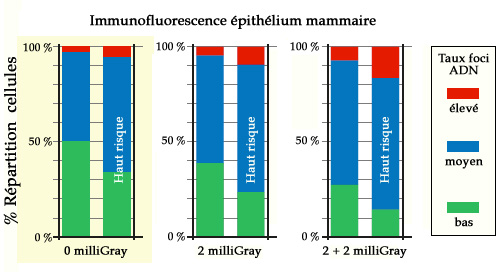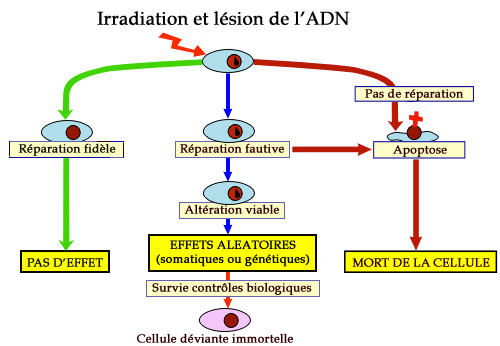Sensitivity of DNA in living cells to radiation
Although we still know little about the effects of low doses of radiation on humans, radiobiologists have made significant progress in understanding the effects of radiation on DNA in living cells.
Over the past decade, the sensitivity of DNA to low doses of radiation has been demonstrated. The technique of immunofluorescence, also known as « γH2AX foci », allows for the visualization of DNA alterations, specifically double-strand breaks (DSBs), at doses as low as 1 milligray (mGy), which is 100 times lower than before. Immunofluorescence has been used for decades, particularly in diagnostic applications. This routine technique allows for the counting of « spots » or « foci » under a microscope, which are closely related to DNA breaks. This has led to a re-evaluation of the fundamental cellular mechanisms involved in individual radiosensitivity, such as cell cycle control, signaling, and DNA repair.
The French Nuclear Safety Authority (ASN) presented the results of a study on double-strand breaks in DNA « γH2AX foci » in breast epithelial cells exposed to ionizing radiation during mammography (2 mGy per incidence). These cells were taken from patients with a personal or family history of breast cancer or without such a history. This immunofluorescence study confirms that we are not all equal in the face of ionizing radiation. Even in the absence of exposure, more alterations (foci) are observed in patients with a history of cancer. The increase in these alterations following exposure highlights individual radiosensitivity in these breast epithelial cells.

Inequality of DNA sensitivity to radiation
The figure compares the distribution of « _foci_ » in DNA from breast cells of women with low or high hereditary risk of breast cancer. In the absence of radiation (left), the population of cells with the most foci (in red) is more numerous in women at high risk. In the middle and right, this population increases for a dose of 2 mGy equivalent to a mammography image and for two repeated irradiations at 3-minute intervals (2+2 mGy). We observe that patients with a family history are the most radiosensitive. © ASN – M. Bourguignon
The radiosensitivity of cells observed at low doses is an argument in favor of the hypothesis that low doses pose a risk. However, multiple factors, such as control mechanisms and repair processes, pose significant hurdles on the path from DNA alterations and damage to the development of cancer or hereditary effects.
Spontaneous DNA damage occurs constantly in our cells, with 3 to 10,000 single-strand breaks and 2 to 8 double-strand breaks per day and per cell under normal conditions. Radiation is just one of many causes.
When DNA damage occurs, normal pathways lead to either faithful repair, direct cell death, or, in a small minority of cases, faulty repair. Radiosensitivity to low doses of ionizing radiation manifests as an increase in cell death and the number of unrepaired DNA breaks and late repair defects.
Among non-repaired cells, the vast majority undergo « apoptosis », or cell death, which halts the anomaly with cell death. Repair itself can occur with varying delays depending on the severity of the damage. The majority is repaired within a timeframe that allows cell survival (from a few hours to one or two days).
Faulty repair can be either lethal (apoptosis again), viable but sterile without the possibility of descendants, or viable and potentially carcinogenic. It is within the small number of faulty repairs that an immortal and carcinogenic cell can arise.

Fate of a damaged cell
To lead to cancer, the deviant cell must also escape micro-tissue control by neighboring cells and immune system control. The final destruction of any deviant cell is much more likely than its survival. Only in the case of faulty repair and survival of all environmental controls can a tumor arise.
© GR21
Finally, a deviant cell, potentially carcinogenic, must survive micro-tissue controls exerted by neighboring cells, immune system control, and the activation of anti-proliferation mechanisms. Due to these effective natural controls, the final destruction of a deviant cell is much more likely than its survival.
Only in the case of faulty repair and inefficient environmental controls can a tumor arise. The process is complex. For example, at low doses, DNA lesions may not be signaled, and therefore not repaired, leading to cell death. There will be no faulty repair and risk of deviant cells.
In the eyes of the ASN, individual radiosensitivity raises a public health issue regarding medical exposures, which are increasingly common. It is therefore essential to control the progression of medical doses by strictly applying the principles of justification and optimization.
Sources:
– Individual Radiosensitivity: Context and Challenges_ by Michel Bourguignon, Revue Contrôle N°197, p 49
– Effects of Low Doses of Irradiation, dossier GR21, Yvon Grall
Other articles on the subject « Radiation Effects »
Deterministic effects
The domain of strong doses and severe, reproducible effects For high doses above a certain thresh[...]
Probabilistic effects
The domain of low and average doses For weak or medium-strength doses, the effects are not as cle[...]
Dose-effects Relationship
Can effects caused by low doses of radiations be predicted ? Even though we are constantly expose[...]
Cumulative Dose
What is the cumulative exposure? We receive an average of 2.5 millisieverts (mSv) per year from n[...]
Dose Rate
Acute and chronic exposures The « effective dose » is not sufficient by itself to characterize on[...]
Hiroshima Nagasaki Survivors
An exces of cancers and leukaemia among survivors Our knowledge of the risks of cancers due to ra[...]
Linear No-threshold Model
A Precautionary Principle applied to radioactivity … Is it possible to predict the effects [...]
Low doses effects
Do low doses of radiation have any effect? Radioprotection experts commonly refer to doses below [...]
Radioactive Toxicity
A useful indicator but to be used appropriately … The danger presented by a radioactive sub[...]
Dose Factors
What doses when swallowing or inhaling radioactive atoms ? How to evaluate the doses resulting fr[...]